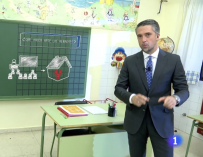Good TV has always learned from the theater. His tricks, his silences, his light, his backlighting, his irruptions on stage, his optical effects, the shadows behind the curtain. In fact, the prestigious beginnings of Televisión Española itself had the proper name of the chain’s largest set, ‘Estudio 1’, which was inaugurated with the recording of Oscar Wilde’s work ‘The ghost of Canterville‘ performed by Juan Guerrero Zamora. There, great functions performed by and for television were performed. It was a quarry of actors and, also, of filmmakers. But in reality, beyond the theatrical genre, all the programs learned from the theater and the best authors on the network were so clever at incorporating the experience of theatrical creativity into the new television machinery. See, for example, Chicho Ibáñez Serrador.
Decades later, in the eighties, Lina Morgan allowed to record his popular performances at the Teatro La Latina. What madness, some said, if they are seen on television afterwards, the spectators will not sit in the stalls, since they have already seen it. Lie. Not only ‘Go for twins‘it swept audiences, it also multiplied the interest in going to see it in situ. The audience wanted to experience the first person experience.

Because TV is a window that discovers us. That is why it is so important that Televisión Española, as a public channel, does not imitate the private channels and dares to set its own agenda by immersing itself at a certain risk where others cannot: in the culture that mobilizes society from below. TVE must disseminate it and, at the same time, immortalize it for the future.
And this Saturday and almost a decade later, La 2 de RTVE has recovered the broadcast of a theatrical production on the occasion of the theater day. It has been with the classic of Federico Garcia Lorca, ‘Mariana Pineda‘, by Laia Marull and directed and versioned by Javier Hernández-Simón.
But it is not enough to broadcast the function from the Spanish Theater and now, this ‘Mariana Pineda’ with the production of Gustavo Jimenez Vera it does not remain in the broadcast from the outside, as if it were the gaze of a distant passive spectator, and sensitively incorporates the arts of television to stage performance. This creates a marriage between television and theater that favors a unique viewing experience by the audience from home.

Each frame has tried to achieve artistic excellence to show with more transparency the textures of the interpretation and, at the same time, explore the beauty that the choreography of the scenography intends. In this way, the production of TVE subtly makes the viewer feel that they are not missing anything and that they are living it with a special charm thanks to the help of expressive shots that play with perspectives that the eye could not reach from the stalls.
Now the challenge is for the theater of our time to be disseminated and portrayed by TVE to invite the audience to come to the rooms, also to capture the independent works that are invisible and immortalize them for the future. But, how to do it in an attractive way in times in which we are immersed in a constant feeling – just a feeling – that we have too much audiovisual offer and the big companies delimit what we should see?

In addition to the broadcast of large productions recorded with a thoughtful prior process like this one, it could be smart to create a large periodic event from TVE to attract the interest of the public with works covered in the station’s own studios and with the ‘run run’ of the channel. public to tuck them in. But to seduce an audience beyond the one that is already up to date in theatrical programming, it is vital to have the adrenaline of the live performance and know how to give interest to the event within a program of its own that contributes the relevance of the context that it explains. the nuances of what is to be seen. In this sense, it has already opened the way ‘Sánchez and Carbonell‘taking to Prado del Rey’s Studio 6 fragments of the theatrical off and wrapping them in the frenzy of a live set with lighting and television photography. A good wedding. At the end of the day, the best television will always be the one that does not remain only in the predominant protocols and dares to launch itself into the well-understood fantasy of the artisanal theater from which we come so that, thus, each project plays until it has its own stamp unique.
– .


